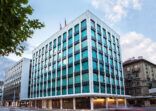Each month we feature the allocation in one of the three portfolios offered by FE Advisory Asia: cautious, balanced and growth. Data is included to show how well the portfolio has done compared to the previous month and year-to-date so that readers can get a sense of performance.
Additionally, Luke Ng, senior VP of research at FE Advisory Asia, provides a concise analysis on macro events and their potential impact on the portfolio.
A breakdown of the balanced portfolio at the end of July 2017. Performance figures are in the menu image above.

Source: FE Advisory Asia
Portfolio breakdown and holdings are based on latest published data for each constituent, which may have publication dates that differ.
Percentages are based on current holdings and should only be used as a guide. Some information is provided to FE from independent third parties whom FE does not control. FE cannot guarantee the accuracy or reliability of the data, or its suitability for use by all investors.

|
How did the market perform in July?
Following the flat June, July proved to be far more positive for equity investors with all major markets returning positive results. Emerging markets generally outperformed developed markets thanks to the weakening US dollar, rising commodity prices and better than expected Chinese growth figures.
The US market hit an all-time high driven by positive macroeconomic data, with the second quarter GDP growth figures hitting 2.6% on an annualised basis and the PMI data hitting a three-year high of 57.8. In Europe, markets were supported by signs of further expansion with French and Spanish data reporting robust growth of 0.5% and 0.9%, respectively, for the previous quarter. Ongoing speculation that the ECB was about to pursue a less expansionary policy led to a strengthening in the euro which pushed returns even higher. The Japanese market rose mildly during the month, with economic numbers released generally in-line with expectations.
In emerging markets, Chinese equities had a strong run as the second quarter GDP increased 6.9% from a year ago. Latin American equities led by Brazil also stood out from the emerging market peers amid a softening in the country’s inflation allowing more room for the central bank to boost growth. The former Brazilian president Luiz Inacio Lula da Silva was convicted for corruption and money laundering and sentenced to nine and a half years. This will likely prevent him from participating in the presidential election next year.
In fixed income, the asset class advanced slightly in July if currency effects are not taken into consideration. While the Bloomberg Barclays Global Aggregate Hedge USD Index rose 0.33% during the month, the unhedged version grew 1.68% amid the weakening of the US dollar.
How did the balanced portfolio perform?
Similar to what we have done in our cautious and growth portfolios, we dialed up the risk budget in our balanced portfolio toward its upper end when we rebalanced the portfolio at the end of May. The move proved supportive to the portfolio in July amid the positive run in the equity markets. By trimming our exposure in fixed income, we were able to initiate a new position in a European equity fund which benefited from the strong market rally. By maintaining a multi-asset portfolio biased toward Asia-Pacific equities, our portfolio should have benefited from the strong rally in the region. However, our holdings in the First State Asia Opportunities and Matthews Asia China Dividend funds underperformed due to their stronger focus on quality and dividend paying/smaller cap, respectively. The Asian market rally during the month was led primarily by large-cap cyclicals and growth.
Within our fixed income exposure, our holdings lagged behind the Bloomberg Barclays Global Aggregate Index in July. This was primarily caused by the negative currency exposure to US dollar instruments. On the other hand, we have been investing into an energy equity fund for diversification purposes and this has served us well during the month, thanks in part to the recovery in oil prices. The fund turned out to be the top performing holding of our portfolio. Overall, in July our balanced portfolio gained 1.11% in US dollar terms.
FE Advisory Asia 2017 portfolio results
| Jan | Feb | Mar | Apr | May | Jun | First half of 2017 | |
| Cautious | 0.78% | 1.28% | 0.77% | 0.71% | 1.05% | 0.44% | 5.15% |
| Balanced | 2.03% | 0.78% | 0.19% | 1.23% | 1.85% | 0.44% | 6.69% |
| Growth | 2.57% | 2.00% | 0.53% | 1.19% | 2.81% | 0.17% | 9.61% |
| Jul | YTD | |
| Cautious | 0.68% | 5.86% |
| Balanced | 1.11% | 7.88% |
| Growth | 2.01% | 11.82% |
Source: FE Advisory Asia. Growth rates in US dollar terms. YTD to end of July 2017.
















